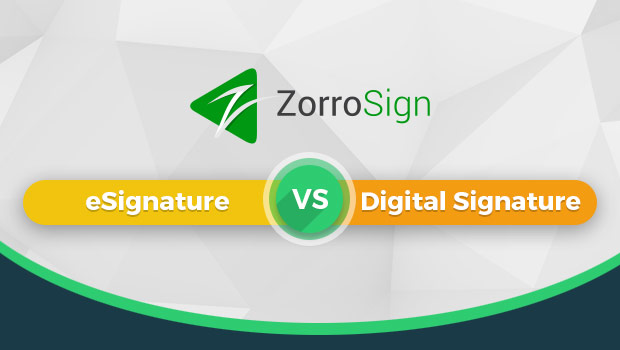- Published on
Difference Between Electronic Signature And Digital Signature
- Authors
-
-
- Name
- Shamsh Hadi
-

As part of their digital transformation, companies are quickly adopting eSignatures and Digital Transaction Management (DTM) to replace their pen-paper-scan-attach-email process. Most organizations stop at eSignature and a handful of them, (more security cautious and risk averse) have gone beyond eSignature and have adopted a Digital Signature into their process. The market in general uses these terms interchangeably but the reality is that they are not the same. These rather complimentary technologies have significant technical differences between them which include how they impact security and process of authentication of your eSign’ed documents and their legal acceptance in courts in case of disputes.
In this article we will explain the difference between the two and share a neat infographics for a quick glance.

E-signature: Under legal parlance, an electronic signature refers to “any electronic indication of intent to agree to a record”. The presence of eSignature has dominantly increased with the passing of E-sign Act in 2000 which makes it legally enforceable. eSignature has its own unique feature and that is its ease of use. Customers get the advantage of signing a document using a verbal signature, like giving consent over the phone, with a simple click on the box, a visual representation of their signature, and any electronically signed authorization. A real electronic signature has four main components:
- Method of signing
- Data Authentication
- User Authentication
- Captured Intent to eSign
eSignatures are not fully regulated compared to digital signatures. Because most electronic signature providers simply use an image of your signature super-imposed on a document, the authenticity and integrity of the document is often questioned as it is difficult to identify the real owner of the document as it is not certified. Just an image of your signature placed on a document cannot be verified especially if someone tampers with the document after it is signed. With ZorroSign, however, the eSignature is real and not just an image and customers are protected against post execution forgery and tampering using our proprietary document 4n6 (Forensics) technology.
Digital Signature: Uses a cryptographic technique. The digital signature encryption helps in securing the data that is associated with the signed document. The formula of a digital signature is that of a validation, like notaries in the past. The notaries were invented when paper-based documents were forged. Even today, notaries play a key role in ensuring and verifying transaction between parties. The same problem exists with eSignatures and digital signature helps in solving this problem and is the online equivalent of the notary.
In the world of digital transactions, the most popular authentication method, Public Key Infrastructures (PKI), is necessary to help ascertain the identity of people signing documents, devices used to sign documents, and services used. PKI goes way beyond the use of user IDs and passwords. It employs cryptographic technologies such as digital signatures and digital certificates to create unique credentials (using combination of public and private keys) that can be validated beyond reasonable doubt and on a mass scale.
The process of applying the digital signature will be explained in the following steps:
- The software creates a unique digital fingerprint (called a hash) of the document content using a mathematical algorithm.
- The hash is encrypted using the signer’s private key.
- The encrypted hash and the signer’s public key will be combined to make a digital signature.
- This digital signature will be attached to the document.
- The digitally signed document is now fully secured and ready to use.
The evolution of online signature is quite significant as it has moved from simply imposing an image of a signature to a multi-layered encryption process. The benefit of an online signature cannot be deciphered in words.The integration of eSignature into the electronic document workflow has always been a top priority for respected eSignature providers like ZorroSign. It is safe to conclude that it has a strong legal presence to that of a wet ink signature as long as it sticks to the terms and conditions of the contracts drawn by (E-sign Act), 2000. ZorroSign adheres to the gold standard of these eSign laws and ensures quality delivery of their product/services to their customers.